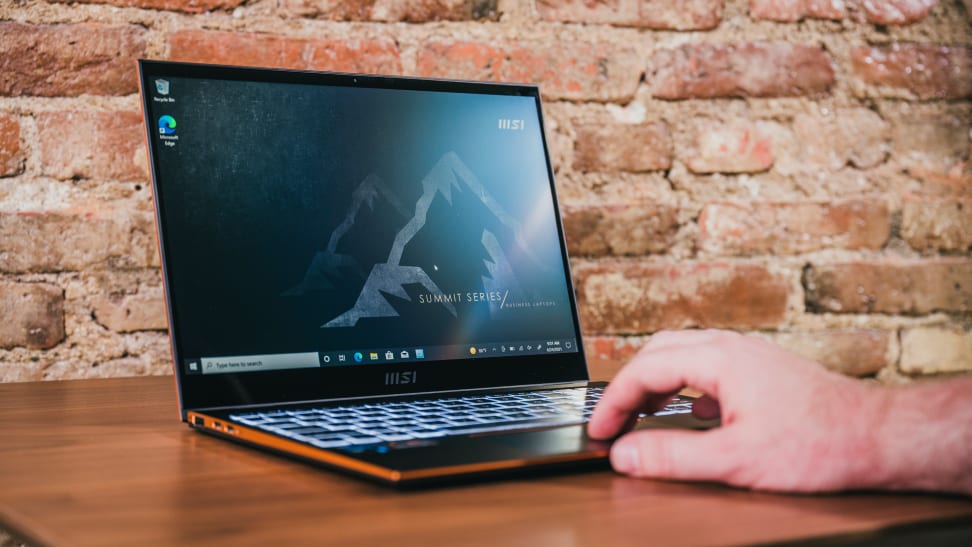Laptop specifications can be misleading—pay attention to this instead
Even if two laptops are configured exactly the same, chances are they won't perform the same
 Credit:
Reviewed / Jackson Ruckar
Credit:
Reviewed / Jackson Ruckar
Products are chosen independently by our editors. Purchases made through our links may earn us a commission.
The mid-90s and early 2000s felt like a simpler time. The internet was mostly Geocities pages, pop music was upbeat, and PC specifications meant something. You could stroll into a big-box retailer confident that the newest, hottest PC would handily outperform last year’s machine. Unfortunately, that’s not true today.
While new models do generally often outperform older machines, the gap is often narrow. Worse, processors and graphics hardware placed in higher tiers, like Intel’s Core i7 or Nvidia’s RTX 30-series, sometimes fail to provide big upgrades over less expensive components. This is especially true among laptops; it's entirely possible to have two identically configured laptops perform differently due to a variety of factors like airflow and temperature.
Here’s why you should pay less attention to specifications—and what you should look for instead.
What’s wrong with specifications, anyway?

While laptop specifics are an important part to consider when shopping around for your next laptop, they can't tell the whole story alone.
The hardware in your computer consumes energy to perform work. It’s not perfectly efficient, though, so some energy is emitted as heat. Heat degrades the hardware’s ability to perform work and, in extreme cases, can cause physical damage. That’s bad, so your computer is programmed to throttle back energy consumption as temperatures rise.
This creates a link between a computer’s ability to manage heat and its maximum performance. Desktops, which can fit big fans and heatsinks, manage heat well. But laptops need to be compact. There’s only so much space for heat pipes and system fans.
The most extreme example was Apple’s 15-inch MacBook Pro from 2018. The top-tier model with an Intel Core i9 processor barely beat the more affordable model with an Intel Core i7. Apple managed to improve results with software updates, but the best solution was to redesign the laptop entirely. That’s what Apple did with 2019’s MacBook Pro 16.
I saw a similar situation while testing Samsung’s new Galaxy Book Pro and Galaxy Book Pro 360. I benchmarked two models: a Galaxy Book Pro with the Core i5 and a Galaxy Book Pro 360 with a Core i7. The Core i7 processor is supposedly quicker, but in my tests, the two were tied.
Put simply, a CPU with better specifications is not guaranteed to perform better than a processor with less impressive specifications when heat forces the processor to throttle back. That’s disappointing, as the “best” processors are sold for hundreds more than their entry-level cousins.
Bigger is better

Thicker laptops like the Acer Nitro 5 generally perform better than thinner laptops because they have more space to displace heat created by the hardware components.
The problem is heat, so cooling is a solution. And, as mentioned, better cooling demands larger fans and thicker heat pipes. The result? Big laptops are quicker than small laptops.
It’s an open secret that entry-level gaming laptops like the Acer Nitro 5 and HP Pavilion Gaming 15 can stand toe-to-toe with much more expensive machines like Dell’s XPS 15 and Microsoft’s 15-inch Surface Laptop 4.
Budget gaming laptops, which often have a Core i5 or entry-level Core i7 processor, are several pounds heavier and nearly twice as thick as their more expensive peers. Yet if you want to cram through a 3D render in Cinebench or edit video, they’ll provide similar or better results at half the price.
If you’re shopping in the 13-inch or 14-inch category, well, you’re facing a real pickle, as proven by Asus’ Vivobook 14 Pro OLED. We reviewed it with an AMD Ryzen 5900HX processor, a processor we also tested in the 15-inch Asus ROG Strix G15 AMD Advantage Edition.
The result? Asus’ 14-inch Vivobook delivered a Cinebench benchmark score almost half that of the 15-inch Asus ROG laptop. It also needed nearly twice as long to render a 3D scene in Blender. I still find it hard to believe the same processor could vary so wildly in real-world results, but the benchmarks were conclusive.
Here’s the truth: you can have a fast laptop, or a compact laptop, but you can’t have both. The old car enthusiast catchphrase, “there’s no replacement for displacement,” a remark on how, if all else is equal, a larger engine will produce more horsepower, now applies to laptops.
RAM upgrades remain a value black hole

While most Chromebooks can benefit from a RAM upgrade, there is such a thing as having too much RAM.
RAM is among the most prominent laptop specifications. It serves as a computer’s short-term memory. It’s easy to advertise because more is always more.
Upgrading from 16GB to 32GB of RAM, for example, exactly doubles capacity. This provides more space to store programs and files in RAM. That can be important because accessing data from RAM is much quicker than accessing data from a hard drive. However, more RAM isn’t useful if you don’t need it. Think of RAM like a travel mug. A big 22-ounce travel mug might seem great. But what if you typically order just 12 ounces of coffee? If that’s true, the extra space is useless. You gain nothing from ten ounces of empty space in your mug.
Upgrading from an Intel Core i3 to a Core i7 isn’t a good idea if you only browse the web, but you at least might see a tiny benefit, as the processor can accelerate every task. But unused RAM is absolutely pointless. You may as well light your cash on fire.
The RAM requirements of modern software began to level out over a decade ago and have barely budged since. Many common applications don’t need large amounts of memory to function well. 8GB of RAM is fine for typical tasks like working with spreadsheets, browsing the web, and watching Netflix. Even the vast majority of PC games don’t demand more than this.
If you’re a heavy multitasker, you want to play the latest PC games, or you work with professional software, then 16GB is a healthy upgrade. Going beyond that isn’t ideal unless you’re working with photos for print publications, editing lengthy 4K videos, or have another specific high-end use case.
Laptop makers push RAM because it tempts shoppers into spending more. If you’re choosing between two identical laptops, but the first has 8GB of RAM for $600 while the second has 16GB for $700, the upgrade might feel like good value. But the leap is only worthwhile if you have some reason to think you need it.
Apple is the exception

Today's MacBooks have their RAM soldered onto the same chip at the CPU and GPU, so make sure the amount you get is really the amount you need.
My advice so far applies to Windows laptops and Chromebooks. It once applied to the MacBook, as well, but in 2020 Apple began transitioning away from Intel’s processors to its homegrown chips based on the same architecture as the processors in its iPhones and iPads.
Apple’s results exceeded all expectations. The MacBook Air with Apple’s M1 chip delivers up to twice the performance of the prior model with an Intel Core i7-1060NG7 processor. A MacBook Air or MacBook Pro 13 can trade blows in benchmarks with a premium 15-inch Windows laptop like the Dell XPS 15. They manage this while using a fraction of the power and, in the case of the MacBook Air, emitting zero fan noise.
You can buy any MacBook Air, MacBook Pro 13, or 24-inch iMac with an Apple M1 chip and expect it to be about as quick as any other model with the M1 chip. Apple does sell entry-level Air and iMac models with a 7-core GPU, while more expensive models have an 8-core GPU. The more expensive models are slightly better in graphics benchmarks, which is what you’d expect based on specifications and pricing.
Apple’s MacBook Pro 14 and Pro 16 are more complex. These models offer an Apple M1 Pro or Max chip with either eight or 10 processor cores and between 14 and 32 graphics cores. The efficiency of Apple’s M1 silicon means you can buy without the worry of thermal throttling, or the processor getting too hot to perform at its peak.
Choosing RAM is simple, though. All MacBooks with an M1 chip have at least 8GB, which is all most people will need. You can upgrade to 16GB in the MacBook Air and Pro 13, or up to 64GB in the MacBook Pro 14 and 16 if you think it necessary.
However, as always, it’s worth considering whether you need the added hardware. Our review of the entry-level MacBook Pro 14 found it delivers solid performance for most users.
Read the reviews and stay skeptical

The best thing you can do before buying a new laptop is read a lot of reviews.
The success of Apple’s new M1 chip aside, anyone shopping for a new laptop this holiday season should do so with a healthy sense of skepticism. Buying the right laptop based on hardware specifications alone is not as easy as it used to be thanks to several factors like airflow and thermals that can affect performance.
There’s one thing that won’t steer you wrong: the reviews. We test dozens of laptops every year, meticulously recording the results to compare machines across categories and years. Benchmarks and comparative testing are the only way to know if a laptop lives up to the specifications on its label or falls short.


